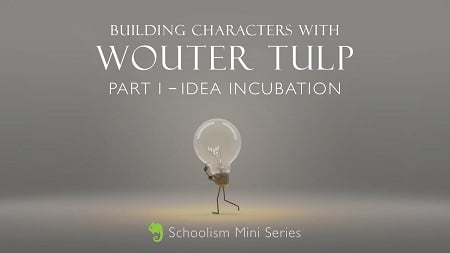
Schoolism – Conceptual Characters with Wouter Tulp | 2.04 GB
Great character designs are more than just beautiful drawings.
In the stories that we love, chracters are actual personalities that we can relate to. In this course, we focus on the ideation process of character design.
We’ll figure out WHO our character is, and WHY they need to look the way they do.
I’ll provide techniques to help you develop ideas for your character, using “the character designer’s toolbox”. This will help you organize your thought process and make sure you will come up with the best possible concepts.
Lesson 1 – The Creative Process
In my first lesson, we will talk about the creative process. Ideas can seem like elusive things: you either have an idea or not. The reality is not so simple! In this lesson, I will show you the technique I use to develop ideas. The process will be divided into steps to help you manage the process of generating ideas.
Lesson 2 – The Character Designer’s Toolbox
Now let’s talk about the character designer’s toolbox, the mental ideation kit we use when coming up with character designs. This is by no means a formula, and I am sure as you gain experience, you will discover many fine aspects to consider when creating characters. Nevertheless, this toolbox is a very helpful starting point to help you generate ideas for your character.
Lesson 3 – Story and Backstory
In this lesson, I will show how the process of association can be used to come up with original ideas for the character by helping you get past that first obvious idea and create ideas that are more unusual or original.
I will also explain how we can use the information that is given in a script or character description to create a backstory that adds to the personality and believability of the character design, and which can become an extra source of inspiration for ideas.
Lesson 4 – Applying Reference
In this lesson, we will examine the difference between symbols and reality, and how we can make use of both in our character designs. I will demonstrate how using reference can help add specific details to your design, and also how you can use reference conceptually and make it part of your ideation process.
Lesson 5 – Posing
When designing a character, I often think of situations that they might get into in order to generate ideas for how they act. In this lesson, I’ll share some visual storytelling techniques I learned as an editorial and children’s book illustrator. We will analyze some signature poses and talk about how they are used to communicate who the character is.
Lesson 6 – Shape Concepts
In this lesson, I will talk about thinking conceptually about shapes, and show my process for developing ideas for a character that are both visually interesting AND say something about who the character is.
Lesson 7 – Outfits
In this lesson, we will explore how we can say something about our character by the outfits they wear. Furthermore, we will look at how we can design the character’s clothes, physique, hair/skin/fur, and props to help visually explain who they are.
Lesson 8 – Style and Color
As a character designer on a project, you are part of a team. You are not the only one creating the visual style of the movie, so you will often have to design within the rules of a world that has already been established. But as a designer, you are also part of the team that creates the rules of the world. Since the characters we design never exist by themselves, in this lesson, we will explore a bit of the worlds they inhabit, and how we can develop design ideas not just for our characters but also for their environments.
Lesson 9 – From Idea to Design
Much of the process of a character designer is developing ideas. But eventually these ideas need to be made visual. The characters will become visual designs hopping around on screen; the wonderful ideas we came up with will need to be communicated to us in a visual, easily readable way. In this final lesson, I will show you how I review all of my sketches, how I decide which ideas to use, which to leave out and why, in order to eventually combine the best ideas into a presentable design.





